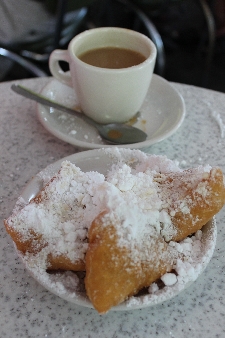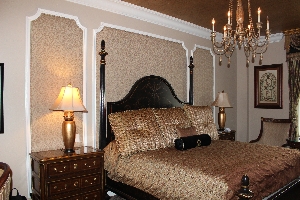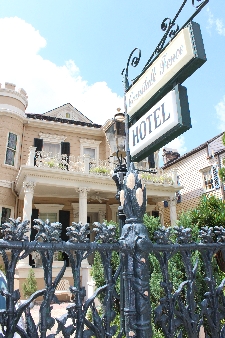Aug
15
Written by:
chris
8/15/2014

A Newbie in New Orleans
It’s my first visit to New Orleans. And I understood immediately why it’s called the Big Easy. This is a laid-back, wide-open city that is perfect for short break vacations. Within an hour of stepping off the plane I am in the French Quarter and being enveloped by the bonhomie of the place. Come and join me on my first experience of New Orleans…
History
It always helps to have an idea of the history of a place. As I wander through the atmospheric streets of the French Quarter on my first evening, I reflect that it’s a bit of a misnomer. It should really be the Spanish Quarter. Sure, the French founded the city in 1718 and named it after the Duc d'Orleans, but in 1762 Spain took over and most of the buildings I’m admiring in the French Quarter were actually constructed by the Spanish. The wrought iron balconies and the bright colours are absolutely delightful. Bourbon Street is garish and brash – but it’s impossible not to be won over by the ebullient spirit of the place.
In 1801 Louisiana returned to French rule, but only two years later Napoleon sold the territory to the United States in the Louisiana Purchase of 1803, which doubled the size of the country at a cost of only $15 million – a steal even then. The revolution in Haiti followed in 1804 and a wave of Haitian refugees came to New Orleans, doubling its population and bringing the Voodoo belief with them.
The next day I explore this Voodoo heritage at the Voodoo Museum, a hole-in-the-wall kind of place in the French Quarter where the front office is manned by a grizzled character who took my admission in one hand and petted his pet snake on his lap with his other. He directed me towards a couple of dark rooms behind him. Here an eclectic collection of voodoo paraphernalia teased the imagination: from skulls to voodoo altars.
New Orleans is famous for its cemetery tours. Most deceased in New Orleans are interred above ground because of the city's high water table and below sea-level elevation. The St Louis Cemetery No 1 was an early cemetery in New Orleans and space was set aside for the burial of African-American Catholics such as “voodoo queen” Marie Laveau. I locate her tomb and that of another Voodoo Queen and find fresh offerings still being placed there…from cigars to casino chips.
The War of 1812 echoed all the way down the Mississippi to New Orleans when the last battle was fought here in January 1815. Major General Andrew Jackson commanded a hotchpotch of American forces to a victory over the British…only to find that a peace treaty had been signed the previous month in Europe! His statue now presides in the eponymous Jackson Square in front of the elegant St Louis Cathedral.
And here adjacent to the square I was able to experience a glimpse of the explosion of colour that is part of the Mardi Gras celebrations in Feb/March by visiting the Louisiana State Museum. Here in the Presbytere, a graceful arched residence built for the Capuchin friars at the neighbouring Cathedral, there is a gorgeous display of the costumes that are such an intrinsic part of the Mardi Gras celebrations. Never was history so vibrant!
Music
What do you do first when you arrive in New Orleans? Head for Bourbon Street, naturally! The evening was just beginning when I strolled across to the iconic street of this joyous city. Already it was bursting with life: street musicians and performers, costumed characters, beads raining down from ornate balconies, burlesque shows and some fine old architecture. I love this place already!
To find the most authentic music in New Orleans, go to where the locals go: Frenchmen Street. It’s just downriver from the French Quarter and the music pours out of clubs and bars, big and small. My favourite is the Spotted Cat – a great jazz group, cozy venue and a funky atmosphere. Seating is limited and dancing erupts spontaneously in front of the band.
The music also takes to the streets as you can see in this photo of another jazz group at a street corner. New Orleans has always been a significant centre for music, showcasing its intertwined European, Latin American, and African cultures. It was the only North American city to allow slaves to gather in public and play their native music, largely in Congo Square, now part of the aptly named Louis Armstrong Park. Here a giant statue of the great man plays on amidst cooling shaded walkways and ponds.
Food
New Orleans is all about music and food… So for my first meal in the city I combined the two. I dined at Arnaud’s Jazz Bistro on the corner of Bourbon and Bienville in the French District. Arnaud’s served up authentic creole cuisine (think shrimp, gumbo, crab cakes and crawfish) while a jazz trio played at close quarters. I could even people-watch across on Bourbon Street! A perfectly scripted end to my first day in The Big Easy.
Here are just a few of the culinary dishes for which New Orleans is famous:
- Gumbo: a culinary carnival created by a mix of West European, African, Caribbean and native Indian influences, featuring okra, meats or seafood…or anything in the kitchen!
- Andouille Sausage is a spiced, heavily smoked pork sausage is a key flavour in many New Orleans dishes.
- Jambalaya: a meal in itself, with sausage, vegetables and a variety of meats or seafood with raw long-grain rice to absorb flavours from the stock.
- Shrimp Creole: offering fresh peeled shrimp, chopped onion, green pepper, green onion and chopped tomato.
- Po-boy: buns usually piled high with meat such as roast beef and topped in debris (the New Orelans version of gravy), turkey or smoked sausage; or fried seafood such as shrimp, catfish or oysters.
- Beignets: decadent treats brought to Louisiana by the Acadians, consisting of a deep fried square piece of dough covered with sinful powdered sugar.
 |
The perfect start to a New Orleans day is cafe au lait and beignets at the Cafe du Monde. The place has been here since 1862 and is a short walk from the French Quarter, the Mississippi River and Jackson Square in the heart of the city. Other restaurants I can personally recommend from my trip here:
- Le Foret: a stylish restaurant for special occasions (I took my wife there for her birthday), the food here is excellent with local touches and warm service. Just off Canal Street.
- Marti’s: a new restaurant with a tapas twist in the north of the French Quarter with great local fish dishes.
- Luke: a John Besh restaurant, this lovely place plays homage to the brasserie traditions of the city and is conveniently situated on Charles Street
- Café at the Square: fresh, bright and with friendly service, this is a good lunch or dinner spot in the business district
Hotels
Hotels.com will make it easy for you to find the perfect place in New Orleans. Here are just four examples of the huge choice available – from a small boutique 14 room hotel in a gorgeous historic Victorian mansion – to a contemporary 117 room hotel packed with local artistry – to an historic Beaux Arts hotel offering outstanding levels of service - to the 254 room Hyatt French Quarter with all the facilities you associate with the Hyatt name.
 |
I am staying in one of New Orleans’s iconic hotels on this trip: Le Pavillon. It is known as “the Belle of New Orleans” for good reason. The lobby and public areas are opulent and the rooms are exquisitely furnished in keeping with the 1907 Beaux Arts building. The photo is of my room, for instance. There are even stories of resident ghosts! But what makes this hotel a standout for me is the warm, friendly service from the staff - many have been there forever and ensure that no need goes unfulfilled. It’s also one of Hotel.com’s highest traveller rated hotels in New Orleans.
 |
 |
The Cornstalk Hotel is in New Orleans’ French Quarter and close to the Voodoo Museum, Jackson Square and New Orleans Jazz Park. It’s a gorgeous Victorian building that is on the National Register of Historic Places. The 'cornstalk' fence was erected in 1840 by the owner who wanted to ease his bride's homesickness for her home state of Iowa. I loved the homely atmosphere of this boutique 14-room hotel – although the place has attracted many famous guests including Bill & Hillary Clinton, and even Elvis himself!
The International House is located just two blocks from the French Quarter and Bourbon Street. It’s alive with the energy of contemporary New Orleans, 23-foot high ceilings in the lobby, ornate pilasters and furniture handcrafted by local artisans. The lobby's handmade chandeliers, a candle-lit bar, and inviting mosaic-designed elevator cabs exude a welcoming and artistic environment. The International House is home to the mood-evoking Loa bar, named after the voodoo term for "divine spirit."
The Hyatt French Quarter is adjacent to Bourbon Street and has been recently renovated to maintain links to its pre-Civil War origins. At one point in its history the building was a department store and the hotel retains alabaster pillars salvaged from the department store's original soda fountain, marble floors, exposed cypress beams in the courtyard and a famous clock, which still hangs from its perch on Canal Street.
Side-tripping to the Swamp
This morning I came face-to-snout with a number of alligators on a must-do trip from New Orleans: a Swamp Tour. I travelled with Cajun Encounters who transported me in a little over an hour from the city delights of New Orleans to one of Louisiana’s untouched wetlands – Honey Island Swamp. It’s a world of ancient cypress trees festooned with Spanish moss hanging over muddy backwaters. Captain Sonny guided the boat expertly around the bayous and backwaters of the Pearl River to where the gators hung out in the turgid waters. We came to within inches of these prehistoric throwbacks – an awesome experience!
There’s much more wildlife in these swamps than just the alligators. I saw wild boar on the banks of the bayou, as well as raccoons that look a whole lot more wild than their city cousins. The birdlife was prolific too: I saw osprey diving for fish and two sorts of heron patiently waiting for dinner to surface. But in some ways the real star of this flora and fauna show is the flora – the great swamp trees and their root systems create a very different ecosystem to any I have seen before.
Getting Around
There are not many major North American cities where getting around the place is half the fun! But here in New Orleans the transport systems are part of the vacation experience. The streetcars of New Orleans are justifiably famous. The longest of New Orleans' streetcar lines, the St. Charles Avenue Streetcar, is the oldest continuously operating street railway system in the world. They combine history with practicality: I have used them extensively as the best way of getting around the city and they are a sightseeing tour in themselves. And at $3 for a day pass, it’s great value too!
New Orleans has four active streetcar lines:
- The St. Charles Streetcar Line is the oldest continuously operating streetcar line in America and each car is a historic landmark. It runs from Canal Street all the way to the other end of St. Charles Avenue, then turns right into South Carrolton Avenue to its terminal at Carrolton and Claiborne.
- The Riverfront Streetcar Line runs parallel to the river from Esplanade Street through the French Quarter to Canal Street to the Arts District. I used it to visit Frenchmen Street.
- The Canal Streetcar Line runs north from the river, up Canal Street, to the entrance of City Park and the Cemeteries.
- The new Loyola-UPT Streetcar Line, opened in 2013, runs along Loyola Avenue from New Orleans Union Passenger Terminal to Canal Street and on to the river..
Another great deal is the Canal Street Ferry which costs $2 each way (note: you need exact change). It’s well worth the ride for the views of the city alone and the chance to sail on the Mississippi River! You great views of the downtown core, the riverboats, the Aquarium and Harrah’s Casino. New Orleans has had continuous ferry service since 1827 and this route connects with the National Historic Landmark District of Algiers Point on the other side of the Mississippi River.
A couple of other fun transport options: the hop-on-hop-off bus tour and the horse-drawn caleches. The former is a good way of getting orientated in the city and spending time at several of the attractions along the way – I enjoyed the views from the top deck. The latter is a genteel way of touring the centre of the city from their base at the foot of Jackson Square.
Thanks
My thanks to Taylor Cole, travel expert at Hotels.com and lover of New Orleans! It is wonderful to be shown around a destination as unique as New Orleans by someone who clearly knows it so well and relishes its every charm and quirk!
Travellers can order a New Orleans Visitors Guide, Visitors Guide at www.neworleanscvb.com and plan their trip on www.Hotels.com.
And one last surprise from New Orleans…It may not be Mardi Gras, but it's the next best thing: the New Orleans Red Dress Run! Thousands of guys and gals were painting the town red this past weekend dressed in red dresses - male and female of course - in a typically New Orleans style fun festival. Somewhere in all that redness there was a 2 mile charity run, but mostly it was about carousing. It was described to me as "a drinking club with a running problem"! Only in NO...
Copyright ©2014 Chris Robinson